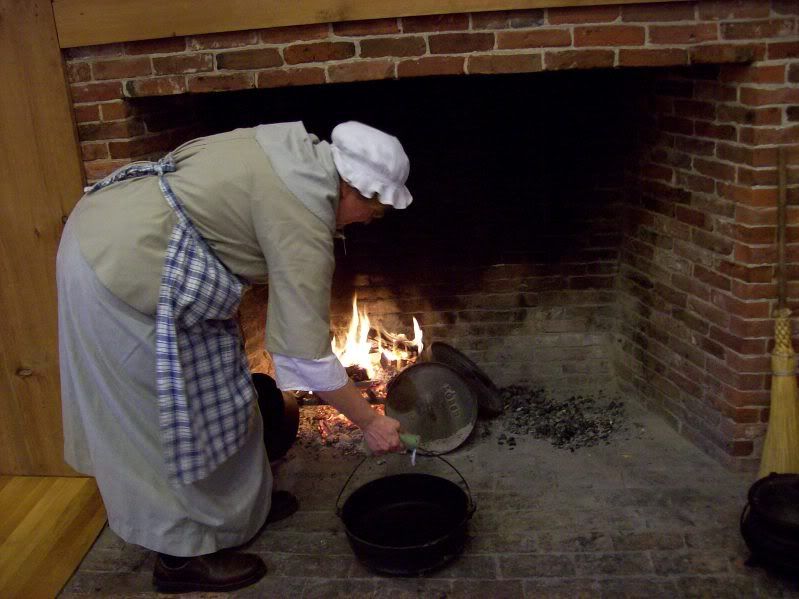
We watched/learned/participated in a hearth cooking lesson (we made apple pear crumble), and had a tour of the house. This was so my thing. History, cooking and being historically accurate?! Awesome!

We started out with some interesting bits of information.
The hearth we cooked in is a replica of a hearth from a 1730s home in Suffield, CT. By this time, the oven part was place to the side of the fireplace, rather than in the fireplace, as it had been before.
 (Image borrowed from Colonial American Life without permission, hopefully they don't mind. Incidentally, I found that blog from a google search, but it's really interesting. Go check it out, if you're into Colonial American stuff)
(Image borrowed from Colonial American Life without permission, hopefully they don't mind. Incidentally, I found that blog from a google search, but it's really interesting. Go check it out, if you're into Colonial American stuff)You can see in the above photo that the oven, the dome-shaped hole, is pretty much above where the fire would be burning. A cook would shovel hot coals into the oven, let it warm up (for about 2 hours), remove the coals and then insert the item to be baked. All while a fire is burning. Can you imagine doing this in long skirts and petticoats?
So in the 18th century, someone came up with the idea of putting the oven on the side, near enough to the fire to shovel the coals in, but so that one wouldn't have to step over the fire to get to the oven. Much better.
 Another important invention was an iron bar on a hinge that could swing out of the fireplace. Most cooking was done by hanging things on this bar, at an appropriate distance from the open flame. It was difficult to get things onto the bar by leaning over the fire, but having one that could swing out made things much safer.
Another important invention was an iron bar on a hinge that could swing out of the fireplace. Most cooking was done by hanging things on this bar, at an appropriate distance from the open flame. It was difficult to get things onto the bar by leaning over the fire, but having one that could swing out made things much safer.And here, I thought the most dangerous part of everyday cooking was burning your hand on a hot pot.
Baking was not only accomplished in a oven as we think of it (a hot box set off to the side somewhere), but also in Dutch ovens. These could be placed on top of a bed of coals, the lid would fit over the base (containing the item to be baked), and a layer of hot coals would be placed on top. One benefit is that the item would bake more evenly- and more quickly, since none of the hot air can escape. (Note: if you ever use a dutch oven to cook meat that's been marinaded in any alcohol, cut down on the alcohol you add, because it won't evaporate like it will in a regular oven. Iiiiiinteresting.)
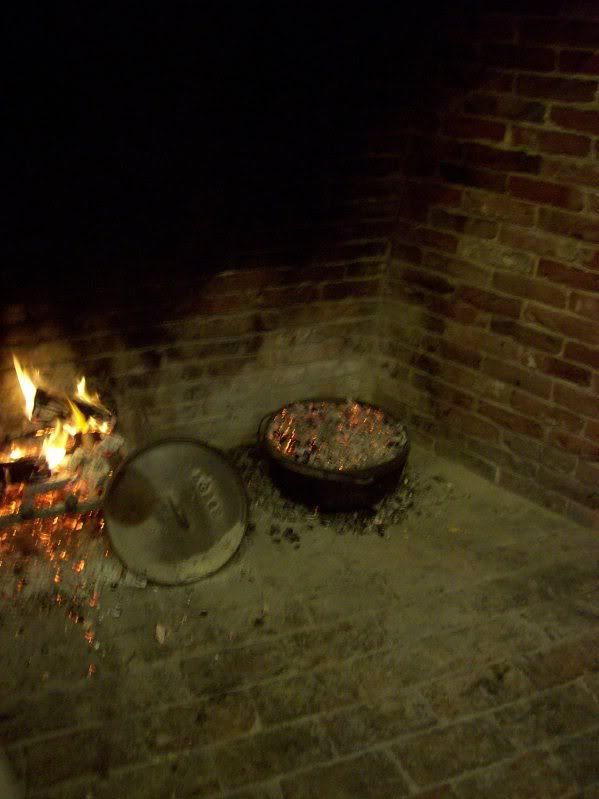
Colonial Americans were complete localvores- they had to be. Now we do it because it's trendy, or because we'd rather support the farm down the road, or because we'd prefer not to waste energy transporting apples from Oregon. But 300 years ago, there was no choice. People in CT ate a lot of fruit (apples, pears, berries, grapes), corn (mostly ground into meal), oats, other local veggies (squash and things from their gardens), and whatever animals were produced locally. Apparently, Farmington was big on sheep (Wolves eat sheep. Wolf Pit Rd is so named because it was formerly a grassy area where they dug pits, covered them with brush, and hoped a wolf would fall in, where they would kill it and turn its pelt in for a reward from the government. Interesting!) Farmington was not big on wheat- it was too humid to grow it there, it usually got too moldy to harvest very much. Threrefore, white flour was fairly expensive, and saved for special occasions. Cornmeal was much more commonly used.
They did, however, import spices and sugar. Sugar was usually brown sugar, which was cheaper, and white sugar was shipped in cone forms, to chip away at when you had tea (not used for cooking as often). Cinnamon, nutmeg and cloves were popular, and were all used whole. Cinnamon and nutmeg (I'm sure everyone knows why CT is called the Nutmeg State) were grated with a grater, and cloves were ground with a mortar and pestle.

Measuring was as precise as it is now, but focused solely on the ratios. Cooks often had a dedicated cooking cup- a mug, a chipped cup, whatever. They knew how much it held, and how to cook with it. It's only recently that the "cup" has turned into an 8oz standard measurement, probably since people don't learn from doing as much as they did 300 years ago.
This is what we learned.
This is what we baked:
Apple Pear Crumble
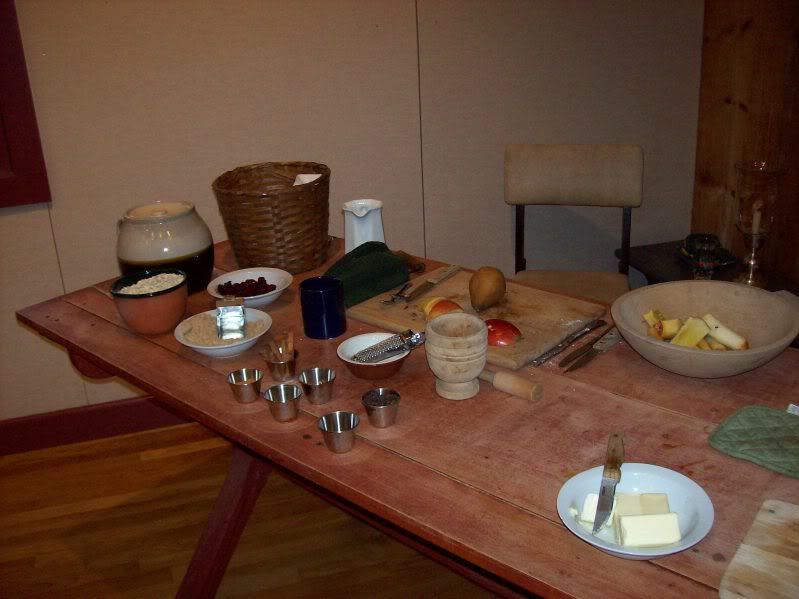
Thinly slice 10 pieces of fruit (a combination of apples and pears, or if using all apples, make sure to use 2 or 3 different varieties of apple, to make more of an interesting flavor). Place in a bowl and pour in enough apple juice to cover all the fruit (about 1cup). Add in 1/2 cup of dried cranberries (or raisins). Sprinkle in 1t cinnamon, 1t nutmeg, and 1/4t cloves. Stir, and set aside.
Whisk together 1cup of whole oats, 1/2cup whole wheat flour (white flour was the most expensive type of flour back then), 1t cinnamon, 1/2cup brown sugar (packed). Melt 1 stick + 1-2T butter and stir into the dry ingredients. (the original recipe actually calls for 2 sticks + 2T butter, which I decided is excessive and unnecessary- we don't need to pack in the calories like they did 300 years ago)
Spoon the apples/pears into a baking dish, spread evenly. Pour the juice over the apples.
 Spread the oat brown sugar topping over the apples. It doesn't have to cover the entire thing, but it should be spread fairly evenly.
Spread the oat brown sugar topping over the apples. It doesn't have to cover the entire thing, but it should be spread fairly evenly.Your dutch oven should have been heating over the fire while you were doing this. (oh, don't you have a cast iron dutch oven and a hearth? Bummer. Preheat the oven to 375oF, then.)
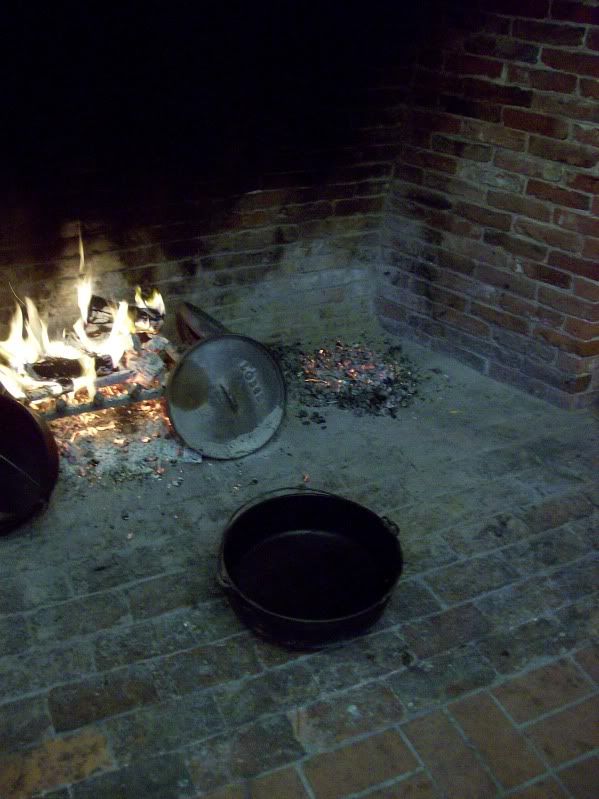
Place the baking dish inside the oven, and place the lid on securely.
 Place the dutch oven on the bed of coals, cover the lid (it really needs to be on tight) with a layer of hot coals, and bake for about 30 min. Or, use your 21st century oven and don't be authentic (but bake for about 1hr 15-30min). Bah.
Place the dutch oven on the bed of coals, cover the lid (it really needs to be on tight) with a layer of hot coals, and bake for about 30 min. Or, use your 21st century oven and don't be authentic (but bake for about 1hr 15-30min). Bah.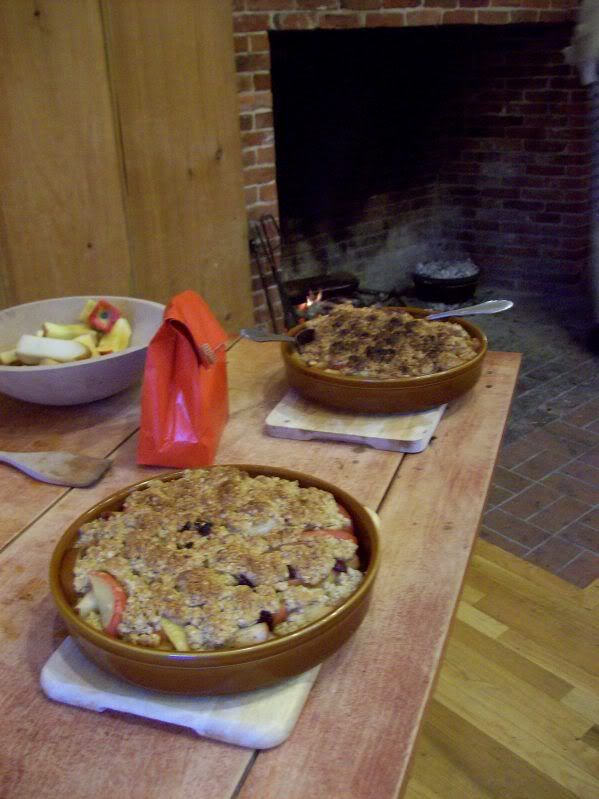 Then eat. Topping a serving with ice cream is not authentic, but I won't say anything.
Then eat. Topping a serving with ice cream is not authentic, but I won't say anything.Note: this topping is better than most of the toppings I've made before. This is now my go-to apple crumble recipe. And I'd need a whole other post on crumble/cobbler/crisp/buckle/grunt. I still haven't figured out the exact differences.
EDIT:After baking this in a modern oven, I have some notes. Bake longer: I ended up baking this in my covered braiser for 1hr 15min, which was fine, but it was much better the next day, after I stuck it in the oven to warm up, and ended up leaving it in there, turning the oven off after 30 min, until we felt like eating it- about an hour.
And I also noticed that at the Stanley Whitman House, she used something other than Quaker Old Fashioned oats. I may have to do a little oat research to figure out what kind she used, because I preferred hers over mine.
1 comment:
Neat! If you ever have time to visit Mystic, I'd be happy to let you get your hands into some 1830s cooking in the Buckingham House.
Post a Comment